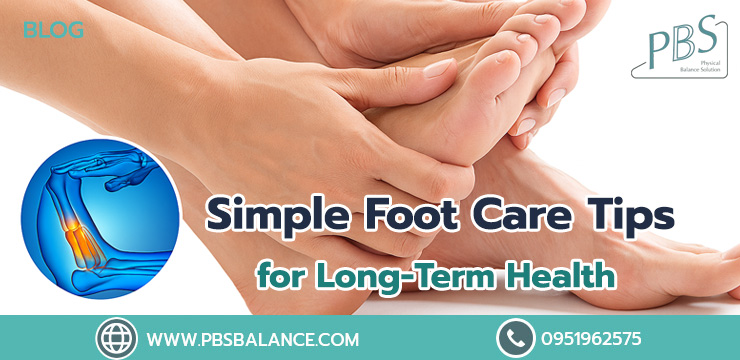
The feet are fundamental to everyday mobility, bearing the body’s weight through approximately 5,000 steps (about 4 kilometers) each day. Despite this continuous demand, the feet are often neglected until discomfort or chronic pain arises, issues that can significantly affect overall well-being.
Proper foot care plays a vital role in maintaining musculoskeletal health and mobility. The following informed advice offers simple, and effective ways to care for your feet at home.
Note: The following recommendations are intended for individuals in generally good health. If you have underlying health conditions, especially diabetes, impaired circulation, or peripheral neuropathy, please consult your physician or a foot care specialist before performing any of these self-care practices.
1. Wear Properly Fitted Footwear
Ill-fitting shoes are a common cause of foot pain, deformities, and long-term musculoskeletal issues. Consider the following guidelines when selecting footwear:
- Avoid tight shoes. Do not purchase shoes with the expectation that they will stretch over time—this often leads to long-term foot discomfort or injury.
- Ensure proper width. The widest part of your foot (metatarsal heads) should align with the widest part of the shoe for optimal comfort.
- Ensure adequate toe box space. While standing, there should be approximately half an inch (1.25 cm) of space between the tip of your longest toe and the front interior of the shoe. This helps prevent the toes from crowding or hitting the shoe, reducing the risk of nail trauma, blisters, or toe deformities.
- Check for overall fit. Shoes should feel snug but not tight or loose around the foot.
2. Soak Feet to Relieve Fatigue
Foot soaking is a simple yet effective method for relieving tension and inflammation after prolonged walking or standing. Soak your feet in warm, clean water, then rinse with cool water to reduce swelling and promote circulation.
3. Moisturize Regularly
After bathing, apply lotion, cream, or gel to keep the skin on your feet moisturized. Avoid applying moisturizer between the toes, as this area should remain dry to prevent fungal infections.
4. Perform Daily Foot Inspections
Regularly examine your feet for the following:
- Cuts, blisters, or wounds
- Localized pain or swelling
- Signs of infection, particularly around the toenails or between the toes
Early detection of abnormalities is critical for preventing complications, especially in individuals with diabetes or peripheral vascular disease.
5. Maintain Proper Toenail Care and Hygiene
To promote healthy feet and prevent ingrown toenails, trim toenails straight across using clean, sanitized nail clippers. Avoid cutting nails too short or rounding the corners, as this increases the risk of the nail growing into the surrounding skin. After trimming, gently file the edges—especially the corners—to smooth any sharp points. Regular toenail hygiene also includes keeping the nail clean and dry to prevent fungal infections and other complications.
6. Remove Calluses and Rough Skin Safely
Calluses (areas of thickened skin) often form in response to pressure or friction. If your feet develop rough skin or calluses:
- Apply moisturizing lotion to soften the area over time.
- Avoid using metal foot files or callus shavers, as these can damage the skin and lead to wounds or infections—particularly dangerous for individuals with diabetes or impaired circulation.
7. Avoid Tight or Worn-Out Shoes
- Tight footwear can cause friction injuries, blisters, and compressive damage to nerves or joints.
- Worn-out shoes often lack proper arch and heel support, increasing the risk of foot fatigue and pain.
Regularly inspect your shoes for signs of deterioration and replace them as needed to ensure continued support and comfort.
8. Limit Use of Flip-Flops
Flip-flop shoes often provide inadequate arch support and can increase heel pressure during walking. For better stability and reduced joint strain:
- Choose footwear with low heels and cushioned soles.
- Look for shoes with built-in arch support to maintain foot alignment and reduce stress on the ankles, knees, and lower legs.
9. Avoid Prolonged Sitting
Sedentary behavior can negatively impact foot health. Extended periods of sitting may cause tightness in the Achilles tendon and plantar fascia, contributing to pain and reduced flexibility in the feet, ankles, and calves.
To promote circulation and tendon health:
- Stand, stretch, or walk for a few minutes every 1–2 hours.
- Incorporate simple calf and plantar fascia stretches into your daily routine.
10. Don’t Ignore Swelling or Persistent Foot Pain
Swelling or pain in the feet or ankles can indicate underlying circulatory problems or musculoskeletal conditions. If these symptoms persist, consult a physician or foot care specialist promptly to prevent further complications.
If you continue to experience persistent foot pain despite trying all natural treatment methods, consult a specialist promptly. At PBS, our team of foot care specialists provides services including custom orthotic insoles for plantar fasciitis and corrective devices for foot alignment. These solutions are personalized to treat the root cause and deliver the best possible outcomes.
Facebook: PBSofficial.TH
LINE Official Account: @pbs.official
Sources:
- https://www.hss.edu/article_caring-for-your-feet.asp
- https://www.webmd.com/skin-problems-and-treatments/healthy-feet-tips
- https://www.healthline.com/health/tips-for-healthy-feet-footwear-hygiene